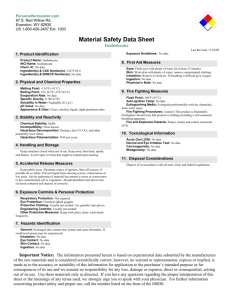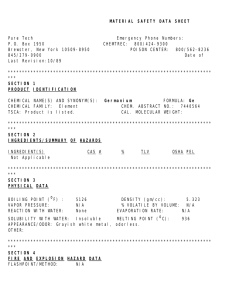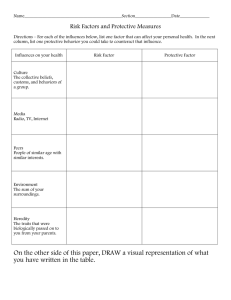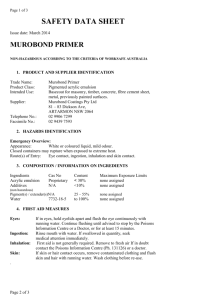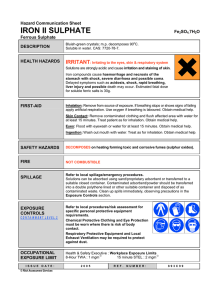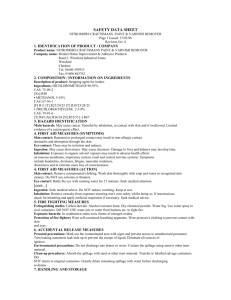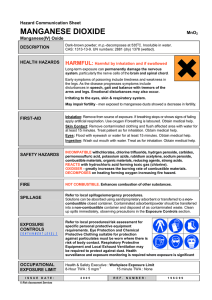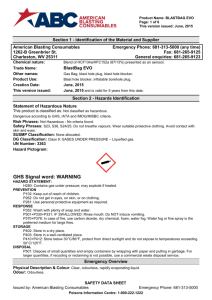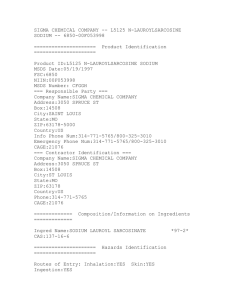klenasol npb - Solvents Australia Pty Ltd
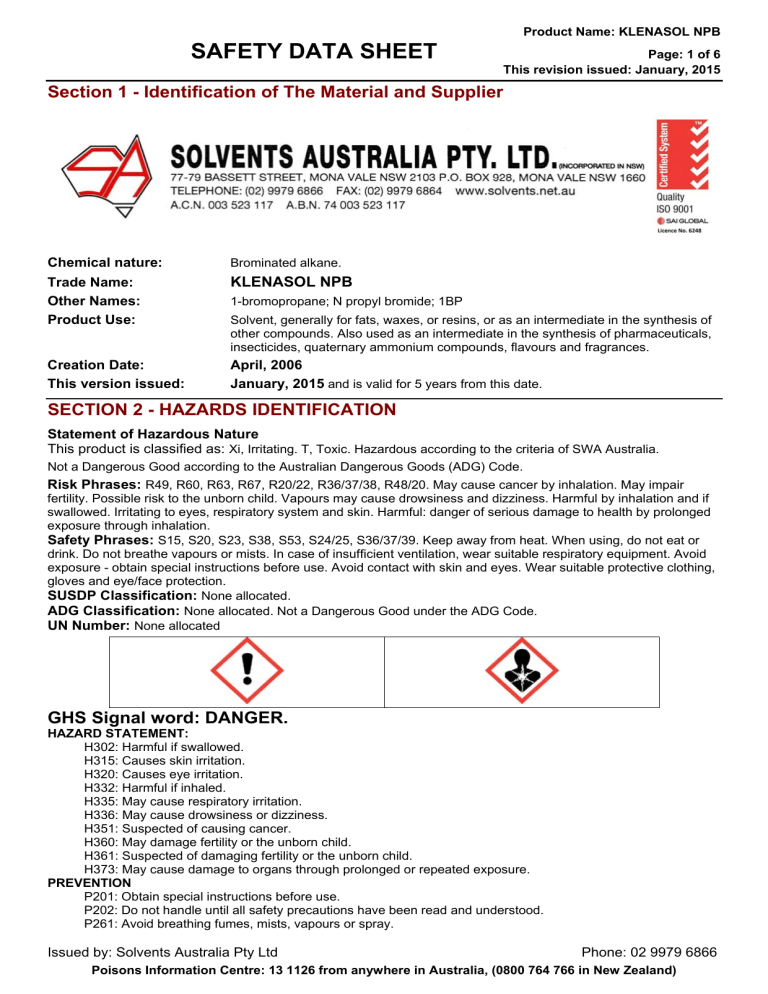
Product Name: KLENASOL NPB
SAFETY DATA SHEET
Section 1 - Identification of The Material and Supplier
Page: 1 of 6
This revision issued: January, 2015
Chemical nature:
Trade Name:
Other Names:
Product Use:
Creation Date:
This version issued:
Brominated alkane.
KLENASOL NPB
1-bromopropane; N propyl bromide; 1BP
Solvent, generally for fats, waxes, or resins, or as an intermediate in the synthesis of other compounds. Also used as an intermediate in the synthesis of pharmaceuticals, insecticides, quaternary ammonium compounds, flavours and fragrances.
April, 2006
January, 2015 and is valid for 5 years from this date.
SECTION 2 - HAZARDS IDENTIFICATION
Statement of Hazardous Nature
This product is classified as: Xi, Irritating. T, Toxic. Hazardous according to the criteria of SWA Australia.
Not a Dangerous Good according to the Australian Dangerous Goods (ADG) Code.
Risk Phrases: R49, R60, R63, R67, R20/22, R36/37/38, R48/20. May cause cancer by inhalation. May impair fertility. Possible risk to the unborn child. Vapours may cause drowsiness and dizziness. Harmful by inhalation and if swallowed. Irritating to eyes, respiratory system and skin. Harmful: danger of serious damage to health by prolonged exposure through inhalation.
Safety Phrases: S15, S20, S23, S38, S53, S24/25, S36/37/39. Keep away from heat. When using, do not eat or drink. Do not breathe vapours or mists. In case of insufficient ventilation, wear suitable respiratory equipment. Avoid exposure - obtain special instructions before use. Avoid contact with skin and eyes. Wear suitable protective clothing, gloves and eye/face protection.
SUSDP Classification: None allocated.
ADG Classification: None allocated. Not a Dangerous Good under the ADG Code.
UN Number: None allocated
GHS Signal word: DANGER.
HAZARD STATEMENT:
H302: Harmful if swallowed.
H315: Causes skin irritation.
H320: Causes eye irritation.
H332: Harmful if inhaled.
H335: May cause respiratory irritation.
H336: May cause drowsiness or dizziness.
H351: Suspected of causing cancer.
H360: May damage fertility or the unborn child.
H361: Suspected of damaging fertility or the unborn child.
H373: May cause damage to organs through prolonged or repeated exposure.
PREVENTION
P201: Obtain special instructions before use.
P202: Do not handle until all safety precautions have been read and understood.
P261: Avoid breathing fumes, mists, vapours or spray.
Issued by: Solvents Australia Pty Ltd Phone: 02 9979 6866
Poisons Information Centre: 13 1126 from anywhere in Australia, (0800 764 766 in New Zealand)
Product Name: KLENASOL NPB
SAFETY DATA SHEET
Page: 2 of 6
This revision issued: January, 2015
P264: Wash contacted areas thoroughly after handling.
P270: Do not eat, drink or smoke when using this product.
P271: Use only outdoors or in a well ventilated area.
P281: Use personal protective equipment as required.
RESPONSE
P312: Call a POISON CENTER or doctor if you feel unwell.
P314: Get medical advice or attention if you feel unwell.
P337: If eye irritation persists: seek medical attention.
P362: Take off contaminated clothing and wash before reuse.
P301+P330+P331: IF SWALLOWED: Rinse mouth. Do NOT induce vomiting.
P302+P352: IF ON SKIN: Wash with plenty of soap and water.
P304+P340: IF INHALED: Remove victim to fresh air and keep at rest in a position comfortable for breathing.
P305+P351+P338: IF IN EYES: Rinse cautiously with water for several minutes. Remove contact lenses, if present and easy to do. Continue rinsing.
P308+P313: If exposed or concerned: Get medical advice.
P332+P313: If skin irritation occurs: Get medical advice.
P337+P313: If eye irritation persists: Get medical advice.
STORAGE
P402+P404: Store in a dry place. Store in a closed container.
P403+P233: Store in a well-ventilated place. Keep container tightly closed.
DISPOSAL
P501: If they can not be recycled, dispose of contents and containers to landfill (see Section 13 of this SDS).
Emergency Overview
Physical Description & colour : Clear colourless to light straw coloured liquid.
Odour: ethereal odour.
Major Health Hazards: harmful by inhalation and if swallowed, irritating to eyes, respiratory system and skin.
Potential Health Effects
Inhalation
Short term exposure: Available data shows that this product is harmful, but symptoms are not available. In addition product is an inhalation irritant. Symptoms may include headache, irritation of nose and throat and increased secretion of mucous in the nose and throat. May cause drowsiness and dizziness.
Long Term exposure: The data are sufficient to conclude that 1-bromopropane caused developmental toxicity, in the form of decreased foetal weight and increased incidence of skeletal variations, in rats exposed to the compound by inhalation on a daily basis during the period of in utero development. See further details in section 11 of this SDS.
In rodents, inhalation exposure to 1-bromopropane caused tumours in several different organs, including the skin, lungs, and large intestine.
Skin Contact:
Short term exposure: Available data indicates that this product is not harmful. It should present no hazards in normal use. However product is a skin irritant. Symptoms may include itchiness and reddening of contacted skin.
Other symptoms may also become evident, but all should disappear once exposure has ceased.
Long Term exposure: No data for health effects associated with long term skin exposure.
Eye Contact:
Short term exposure : This product is an eye irritant. Symptoms may include stinging and reddening of eyes and watering which may become copious. Other symptoms may also become evident. If exposure is brief, symptoms should disappear once exposure has ceased. However, lengthy exposure or delayed treatment may cause permanent damage.
Long Term exposure : No data for health effects associated with long term eye exposure.
Ingestion:
Short term exposure : Significant oral exposure is considered to be unlikely. Available data shows that this product is harmful, but symptoms are not available. However, this product is an oral irritant. Symptoms may include burning sensation and reddening of skin in mouth and throat. Other symptoms may also become evident, but all should disappear once exposure has ceased.
Long Term exposure : No data for health effects associated with long term ingestion.
Issued by: Solvents Australia Pty Ltd Phone: 02 9979 6866
Poisons Information Centre: 13 1126 from anywhere in Australia, (0800 764 766 in New Zealand)
Product Name: KLENASOL NPB
SAFETY DATA SHEET
Page: 3 of 6
This revision issued: January, 2015
Carcinogen Status:
SWA: No significant ingredient is classified as carcinogenic by SWA.
NTP: Propane, 1-bromo- is classified by NTP as reasonably anticipated to be carcinogenic to humans.
See the NTP website for further details.
IARC: No significant ingredient is classified as carcinogenic by IARC.
SECTION 3 - COMPOSITION/INFORMATION ON INGREDIENTS
Ingredients
Propane, 1-bromo-
Stabiliser
CAS No Conc,%
106-94-5 94.1 proprietary 5.9
TWA (mg/m
3 not set * not set
(mg/m
3
) not set not set
*HSE: not set
MAK: not set
USEPA: 25 ppm
California OSHSB: 5 ppm
ACGIH in 2014, proposed a guideline of 0.1 ppm (ACGIH is not a regulatory or standards setting body).
This is a commercial product whose exact ratio of components may vary slightly. Minor quantities of other non hazardous ingredients are also possible.
The TWA exposure value is the average airborne concentration of a particular substance when calculated over a normal 8 hour working day for a 5 day working week. The STEL (Short Term Exposure Limit) is an exposure value that may be equalled (but should not be exceeded) for no longer than 15 minutes and should not be repeated more than 4 times per day. There should be at least 60 minutes between successive exposures at the
STEL. The term "peak "is used when the TWA limit, because of the rapid action of the substance, should never be exceeded, even briefly.
SECTION 4 - FIRST AID MEASURES
General Information:
You should call The Poisons Information Centre if you feel that you may have been poisoned, burned or irritated by this product. The number is 13 1126 from anywhere in Australia (0800 764 766 in New Zealand) and is available at all times. Have this SDS with you when you call.
Inhalation: If symptoms of poisoning become evident, contact a Poisons Information Centre, or call a doctor at once. Remove source of contamination or move victim to fresh air. If breathing is difficult, oxygen may be beneficial if administered by trained personnel, preferably on a doctor's advice. DO NOT allow victim to move about unnecessarily. Symptoms of pulmonary oedema can be delayed up to 48 hours after exposure.
Skin Contact: Wash gently and thoroughly with warm water (use non-abrasive soap if necessary) for 10-20 minutes or until product is removed. Under running water, remove contaminated clothing, shoes and leather goods (e.g. watchbands and belts) and completely decontaminate them before reuse or discard. If irritation persists, repeat flushing and seek medical attention.
Eye Contact: Immediately flush the contaminated eye(s) with lukewarm, gently flowing water for 20 minutes or until the product is removed, while holding the eyelid(s) open. Take care not to rinse contaminated water into the unaffected eye or onto the face. Obtain medical attention immediately. Take special care if exposed person is wearing contact lenses.
Ingestion: If swallowed, do NOT induce vomiting. Wash mouth with water and contact a Poisons Information
Centre, or call a doctor.
SECTION 5 - FIRE FIGHTING MEASURES
Fire and Explosion Hazards : There is a slight risk of an explosion from this product if commercial quantities are involved in a fire. Violent steam generation or eruption may occur upon application of direct water stream on hot liquids. Vapours from this product are heavier than air and may accumulate in sumps, pits and other low-lying spaces, forming potentially explosive mixtures. They may also flash back considerable distances.
Fire decomposition products from this product may be toxic if inhaled. Take appropriate protective measures.
Extinguishing Media : Preferred extinguishing media are carbon dioxide, dry chemical, foam, water fog, dry sand.
Fire Fighting : If a significant quantity of this product is involved in a fire, call the fire brigade.
Flash point : No flash point, ASTM D93 Method A
Upper Flammability Limit: 8.5%
Lower Flammability Limit: 4.6%
Autoignition temperature: 490°C
Flammability Class: Not
Issued by: Solvents Australia Pty Ltd Phone: 02 9979 6866
Poisons Information Centre: 13 1126 from anywhere in Australia, (0800 764 766 in New Zealand)
Product Name: KLENASOL NPB
SAFETY DATA SHEET
Page: 4 of 6
This revision issued: January, 2015
SECTION 6 - ACCIDENTAL RELEASE MEASURES
Accidental release : In the event of a major spill, prevent spillage from entering drains or water courses. Evacuate the spill area and deny entry to unnecessary and unprotected personnel. Wear full protective clothing including eye/face protection. All skin areas should be covered. See below under Personal Protection regarding Australian
Standards relating to personal protective equipment. Suitable materials for protective clothing include PVC and Viton.
Eye/face protective equipment should comprise as a minimum, protective goggles. If there is a significant chance that vapours or mists are likely to build up in the cleanup area, we recommend that you use a respirator. It should be fitted with a type A cartridge, suitable for organic vapours.
Stop leak if safe to do so, and contain spill. Absorb onto sand, vermiculite or other suitable absorbent material. If spill is too large or if absorbent material is not available, try to create a dike to stop material spreading or going into drains or waterways. Sweep up and shovel or collect recoverable product into labelled containers for recycling or salvage, and dispose of promptly. Recycle containers wherever possible after careful cleaning. After spills, wash area preventing runoff from entering drains. If a significant quantity of material enters drains, advise emergency services.
This material may be suitable for approved landfill. Ensure legality of disposal by consulting regulations prior to disposal. Thoroughly launder protective clothing before storage or re-use. Advise laundry of nature of contamination when sending contaminated clothing to laundry.
SECTION 7 - HANDLING AND STORAGE
Handling : Keep exposure to this product to a minimum, and minimise the quantities kept in work areas. Check
Section 8 of this SDS for details of personal protective measures, and make sure that those measures are followed.
The measures detailed below under "Storage" should be followed during handling in order to minimise risks to persons using the product in the workplace. Also, avoid contact or contamination of product with incompatible materials listed in Section 10.
Storage : Note that this product is combustible and therefore, for Storage, meets the definition of Dangerous Goods in some states. If you store large quantities (tonnes) of such products, we suggest that you consult your state's
Dangerous Goods authority in order to clarify your obligations regarding their storage.
Store packages of this product in a cool place. Make sure that containers of this product are kept tightly closed. Keep containers dry and away from water. Keep containers of this product in a well ventilated area. Make sure that the product does not come into contact with substances listed under "Incompatibilities" in Section 10. Some liquid preparations settle or separate on standing and may require stirring before use. Check packaging - there may be further storage instructions on the label.
SECTION 8 - EXPOSURE CONTROLS AND PERSONAL PROTECTION
The following Australian Standards will provide general advice regarding safety clothing and equipment:
Respiratory equipment: AS/NZS 1715 , Protective Gloves: AS 2161 , Industrial Clothing: AS2919 , Industrial Eye
Protection: AS1336 and AS/NZS 1337 , Occupational Protective Footwear: AS/NZS2210 .
SWA Exposure Limits TWA (mg/m
3
) STEL
Exposure limits have not been established by SWA for any of the significant ingredients in this product.
Other bodies have exposure values as follows:
HSE: not set MAK: not set
USEPA: 25 ppm California OSHSB: 5 ppm
ACGIH in 2014, proposed a guideline of 0.1 ppm (ACGIH is not a regulatory or standards setting body).
No special equipment is usually needed when occasionally handling small quantities. The following instructions are for bulk handling or where regular exposure in an occupational setting occurs without proper containment systems.
Ventilation: This product should only be used where there is ventilation that is adequate to keep exposure below the TWA levels. If necessary, use a fan.
Eye Protection: Protective glasses or goggles should be worn when this product is being used. Failure to protect your eyes may cause them harm. Emergency eye wash facilities are also recommended in an area close to where this product is being used.
Skin Protection: Prevent skin contact by wearing impervious gloves, clothes and, preferably, apron. Make sure that all skin areas are covered. See below for suitable material types.
Protective Material Types: We suggest that protective clothing be made from the following materials: PVC and viton.
Respirator: Where there is a risk of exposure to this product, we recommend that you use a respirator. It should be fitted with a type A cartridge, suitable for organic vapours.
Eyebaths or eyewash stations and safety deluge showers should be provided near to where this product is being used.
Issued by: Solvents Australia Pty Ltd Phone: 02 9979 6866
Poisons Information Centre: 13 1126 from anywhere in Australia, (0800 764 766 in New Zealand)
Product Name: KLENASOL NPB
SAFETY DATA SHEET
Page: 5 of 6
This revision issued: January, 2015
SECTION 9 - PHYSICAL AND CHEMICAL PROPERTIES:
Physical Description & colour : Clear colourless to light straw coloured liquid.
Odour: ethereal
Boiling Point: 68°C at 100kPa
Freezing/Melting Point: -110°C
Volatiles: Completely volatile at 100°C.
Vapour Pressure:
Specific Gravity:
14.65 kPa at 20°C
Vapour Density: No
1.35 at 20°C
Water Solubility: 2.4g/L at 20°C pH: No
Volatility: No
Odour Threshold: No
Evaporation Rate: No
Coeff Oil/water distribution : No
Autoignition temp: 490°C
SECTION 10 - STABILITY AND REACTIVITY
Reactivity : This product is unlikely to react or decompose under normal storage conditions. However, if you have any doubts, contact the supplier for advice on shelf life properties.
Conditions to Avoid: This product should be kept in a cool place, preferably below 30°C. Keep containers tightly closed. Containers should be kept dry. Keep containers and surrounding areas well ventilated.
Incompatibilities: oxidising agents.
Fire Decomposition: Carbon dioxide, and if combustion is incomplete, carbon monoxide and smoke. Water, bromine compounds. Carbon monoxide poisoning produces headache, weakness, nausea, dizziness, confusion, dimness of vision, disturbance of judgment, and unconsciousness followed by coma and death.
Polymerisation: This product will not undergo polymerisation reactions.
SECTION 11 - TOXICOLOGICAL INFORMATION
Local Effects:
Target Organs: lungs, eyes, reproductive system
Classification of Hazardous Ingredients
Propane, 1-bromo- Conc>=20%: T; R60; R63; R48/20; R36/37/38
Propane, 1-bromo-: LD
50
Oral, Rat 4260mg/kg LD
50
Oral, Rabbit = 540mg/kg
In 2014, the National Toxicology Program in USA listed 1-bromopropane as “ Reasonably anticipated to be a human carcinogen ”
They noted:
“1-Bromopropane is reasonably anticipated to be a human carcinogen based on sufficient evidence of carcinogenicity from studies in experimental animals. 1-Bromopropane, either directly or via reactive metabolites, causes molecular alterations that typically are associated with carcinogenesis, including genotoxicity, oxidative stress, and glutathione depletion. These alterations, observed mainly in vitro and in toxicity studies in rodents, are relevant to possible mechanisms of human carcinogenicity and support the relevance of the cancer studies in experimental animals to human carcinogenicity.”
Inhalation exposure to 1-bromopropane caused tumours in two rodent species and at several different tissue sites, including one tissue site in rats at which tumours are rare (NTP 2011).
1-Bromopropane is well absorbed following ingestion, inhalation, or dermal exposure. Occupational exposure occurs primarily by inhalation and dermal contact. Unmetabolized 1-bromopropane has been detected in the urine of exposed workers at levels significantly correlated with exposure to 1-bromopropane in air (Kawai et al. 2001, Ichihara et al. 2004).
SECTION 12 - ECOLOGICAL INFORMATION
Insufficient data to be sure of status.
Ecotoxicity: Fish: LC
50
Fathead Minnow: 67.3 mg/L; 96H; EC
50
Daphnia: 208.9 mg/L; 24H
EC
50
is the effective concentration of the substance in water which renders 50% of the daphnia unable to swim.
Issued by: Solvents Australia Pty Ltd Phone: 02 9979 6866
Poisons Information Centre: 13 1126 from anywhere in Australia, (0800 764 766 in New Zealand)
Product Name: KLENASOL NPB
SAFETY DATA SHEET
Page: 6 of 6
This revision issued: January, 2015
SECTION 13 - DISPOSAL CONSIDERATIONS
Disposal: This product may be recycled if unused, or if it has not been contaminated so as to make it unsuitable for its intended use. If it has been contaminated, it may be possible to reclaim the product by filtration, distillation or some other means. If neither of these options is suitable, consider controlled incineration, or landfill.
SECTION 14 - TRANSPORT INFORMATION
ADG Code: This product is not classified as a Dangerous Good. No special transport conditions are necessary unless required by other regulations.
SECTION 15 - REGULATORY INFORMATION
AICS: All of the significant ingredients in this formulation are compliant with NICNAS regulations.
SECTION 16 - OTHER INFORMATION
This SDS contains only safety-related information. For other data see product literature.
Acronyms:
ADG Code
AICS
SWA
CAS Number
Hazchem Code
Australian Code for the Transport of Dangerous Goods by Road and Rail, 7th Edition
Australian Inventory of Chemical Substances
Safe Work Australia, formerly ASCC and NOHSC
Chemical Abstracts Service Registry Number
Emergency action code of numbers and letters that provide information to emergency services especially firefighters
IARC
NOS
International Agency for Research on Cancer
Not otherwise specified
NTP National Toxicology Program (USA)
R-Phrase Risk
SUSDP Standard for the Uniform Scheduling of Drugs & Poisons
UN Number Number
THIS SDS SUMMARISES OUR BEST KNOWLEDGE OF THE HEALTH AND SAFETY HAZARD INFORMATION OF THE PRODUCT AND HOW
TO SAFELY HANDLE AND USE THE PRODUCT IN THE WORKPLACE. EACH USER MUST REVIEW THIS SDS IN THE CONTEXT OF HOW
THE PRODUCT WILL BE HANDLED AND USED IN THE WORKPLACE.
IF CLARIFICATION OR FURTHER INFORMATION IS NEEDED TO ENSURE THAT AN APPROPRIATE RISK ASSESSMENT CAN BE MADE,
THE USER SHOULD CONTACT THIS COMPANY SO WE CAN ATTEMPT TO OBTAIN ADDITIONAL INFORMATION FROM OUR SUPPLIERS
OUR RESPONSIBILITY FOR PRODUCTS SOLD IS SUBJECT TO OUR STANDARD TERMS AND CONDITIONS, A COPY OF WHICH IS SENT
TO OUR CUSTOMERS AND IS ALSO AVAILABLE ON REQUEST.
Please read all labels carefully before using product.
This SDS is prepared in accord with the SWA document “Preparation of Safety Data Sheets for Hazardous
Chemicals - Code of Practice” (December 2011)
Copyright © Kilford & Kilford Pty Ltd, January, 2015. http://www.kilford.com.au/ Phone (02)9251 4532
Issued by: Solvents Australia Pty Ltd Phone: 02 9979 6866
Poisons Information Centre: 13 1126 from anywhere in Australia, (0800 764 766 in New Zealand)
